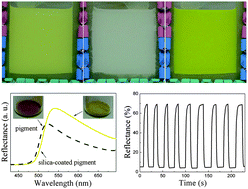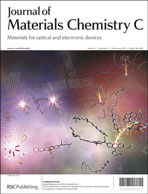CYM and RGB colored electronic inks based on silica-coated organic pigments for full-color electrophoretic displays
Abstract
Chromatic organic pigment–SiO2 composite particles with six different colors (CYM and RGB) were prepared by a modified sol–gel method. With the aid of a cationic polyelectrolyte, poly(diallyldimethylammoniumchloride), amorphous silica was coated onto the surface of organic pigments which was revealed by the variation of the zeta potential and average particle size, together with TEM images and EDX and XPS results. Because of the fine scattering properties of silica to visible light, the intensity of the reflectance peak increased significantly, which makes the composite particles more vivid than the organic pigments. The chromatic electrophoretic suspension was prepared by mixing Span 85 and the composite particles anchored with a self-made block copolymer PLMA-b-PDMAEMA in tetrachloroethylene. All the colored ink particles have similar zeta potentials and mobility of about 30 mV and 4–5 × 10−10 m2 V−1 s−1, respectively. White/color (CYM and RGB) dual-particle electronic ink containing PLMA-b-PDMAEMA treated pigment–SiO2 composite particles and TiO2 grafted with a polymer present excellent performance and quick response under an applied DC field of 0.15 V μm−1.


 Please wait while we load your content...
Please wait while we load your content...